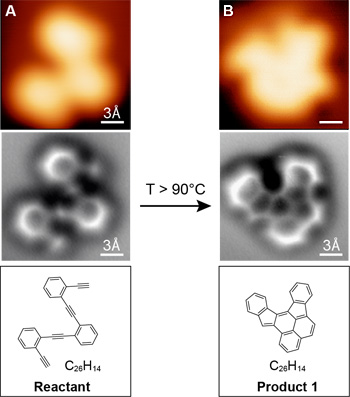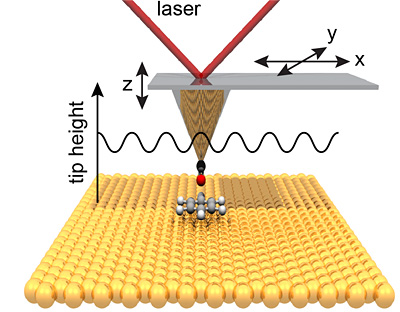Scientists capture first images of molecules before and after reaction
Every chemist’s dream – to snap an atomic-scale picture of a chemical before and after it reacts – has now come true, thanks to a new technique developed by chemists and physicists at the University of California, Berkeley.
Using a state-of-the-art atomic force microscope, the scientists have taken the first atom-by-atom pictures, including images of the chemical bonds between atoms, clearly depicting how a molecule’s structure changed during a reaction. Until now, scientists have only been able to infer this type of information from spectroscopic analysis.

“Even though I use these molecules on a day to day basis, actually being able to see these pictures blew me away. Wow!” said lead researcher Felix Fischer, UC Berkeley assistant professor of chemistry. “This was what my teachers used to say that you would never be able to actually see, and now we have it here.”
The ability to image molecular reactions in this way will help not only chemistry students as they study chemical structures and reactions, but will also show chemists for the first time the products of their reactions and help them fine-tune the reactions to get the products they want. Fischer, along with collaborator Michael Crommie, a UC Berkeley professor of physics, captured these images with the goal of building new graphene nanostructures, a hot area of research today for materials scientists because of their potential application in next-generation computers.
“However, the implications go far beyond just graphene,” Fischer said. “This technique will find application in the study of heterogeneous catalysis, for example,” which is used widely in the oil and chemical industries. Heterogeneous catalysis involves the use of metal catalysts like platinum to speed reactions, as in the catalytic converter of a car.
“To understand the chemistry that is actually happening on a catalytic surface, we need a tool that is very selective and tells us which bonds have actually formed and which ones have been broken,” he added. “This technique is unique out there right now for the accuracy with which it gives you structural information. I think it’s groundbreaking.”
“The atomic force microscope gives us new information about the chemical bond, which is incredibly useful for understanding how different molecular structures connect up and how you can convert from one shape into another shape,” said Crommie. “This should help us to create new engineered nanostructures, such as bonded networks of atoms that have a particular shape and structure for use in electronic devices. This points the way forward.”
Fischer and Crommie, along with other colleagues at UC Berkeley, in Spain and at the Lawrence Berkeley National Laboratory (LBNL), published their findings online May 30 in the journal Science Express.
From shadow to snapshot
Traditionally, Fischer and other chemists conduct detailed analyses to determine the products of a chemical reaction, and even then, the actual three-dimensional arrangement of atoms in these products can be ambiguous.
“In chemistry you throw stuff into a flask and something else comes out, but you typically only get very indirect information about what you have,” Fischer said. “You have to deduce that by taking nuclear magnetic resonance, infrared or ultraviolet spectra. It is more like a puzzle, putting all the information together and then nailing down what the structure likely is. But it is just a shadow. Here we actually have a technique at hand where we can look at it and say this is exactly the molecule. It’s like taking a snapshot of it.”

Fischer is developing new techniques for making graphene nanostructures that display unusual quantum properties that could make them useful in nano-scale electronic devices. The carbon atoms are in a hexagonal arrangement like chicken wire. Rather than cutting up a sheet of pure carbon – graphene – he hopes to place a bunch of smaller molecules onto a surface and induce them to zip together into desired architectures. The problem, he said, is how to determine what has actually been made.
That’s when he approached Crommie, who uses atomic force microscopes to probe the surfaces of materials with atomic resolution and even move atoms around individually on a surface. Working together, they devised a way to chill the reaction surface and molecules to the temperature of liquid helium – about 4 Kelvin, or 270 degrees Celsius below zero – which stops the molecules from jiggling around. They then used a scanning tunneling microscope to locate all the molecules on the surface, and zeroed in on several to probe more finely with the atomic force microscope. To enhance the spatial resolution of their microscope they put a single carbon monoxide molecule on the tip, a technique called non-contact AFM first used by Gerhard Meyer and collaborators at IBM Zurich to image molecules several years ago.
After imaging the molecule – a “cyclic” structure with several hexagonal rings of carbon that Fischer created especially for this experiment – Fischer, Crommie and their colleagues heated the surface until the molecule reacted, and then again chilled the surface to 4 Kelvin and imaged the reaction products.
“By doing this on a surface, you limit the reactivity but you have the advantage that you can actually look at a single molecule, give that molecule a name or number, and later look at what it turns into in the products,” he said.
“Ultimately, we are trying to develop new surface chemistry that allows us to build higher ordered architectures on surfaces, and these might lead into applications such as building electronic devices, data storage devices or logic gates out of carbon materials.”
The research is coauthored by Dimas G. de Oteyza, Yen-Chia Chen, Sebastian Wickenburg, Alexander Riss, Zahra Pedramrazi and Hsin-Zon Tsai of UC Berkeley’s Department of Physics; Patrick Gorman and Grisha Etkin of the Department of Chemistry; and Duncan J. Mowbray and Angel Rubio from research centers in San Sebastián, Spain. Crommie, Fischer, Chen and Wickenburg also have appointments at Lawrence Berkeley National Laboratory.
The work is sponsored by the Office of Naval Research, the Department of Energy and the National Science Foundation.
